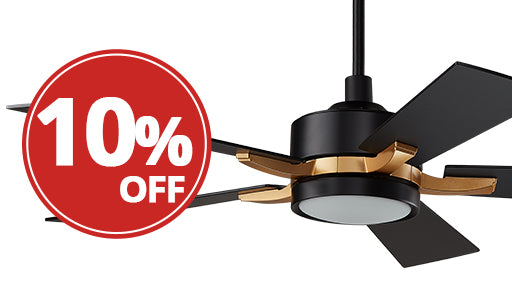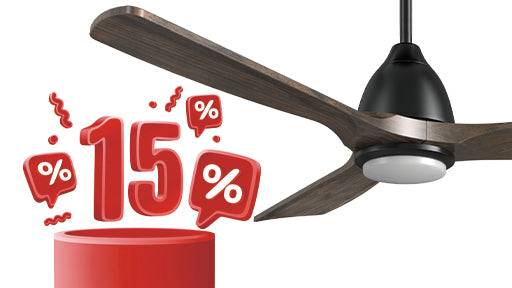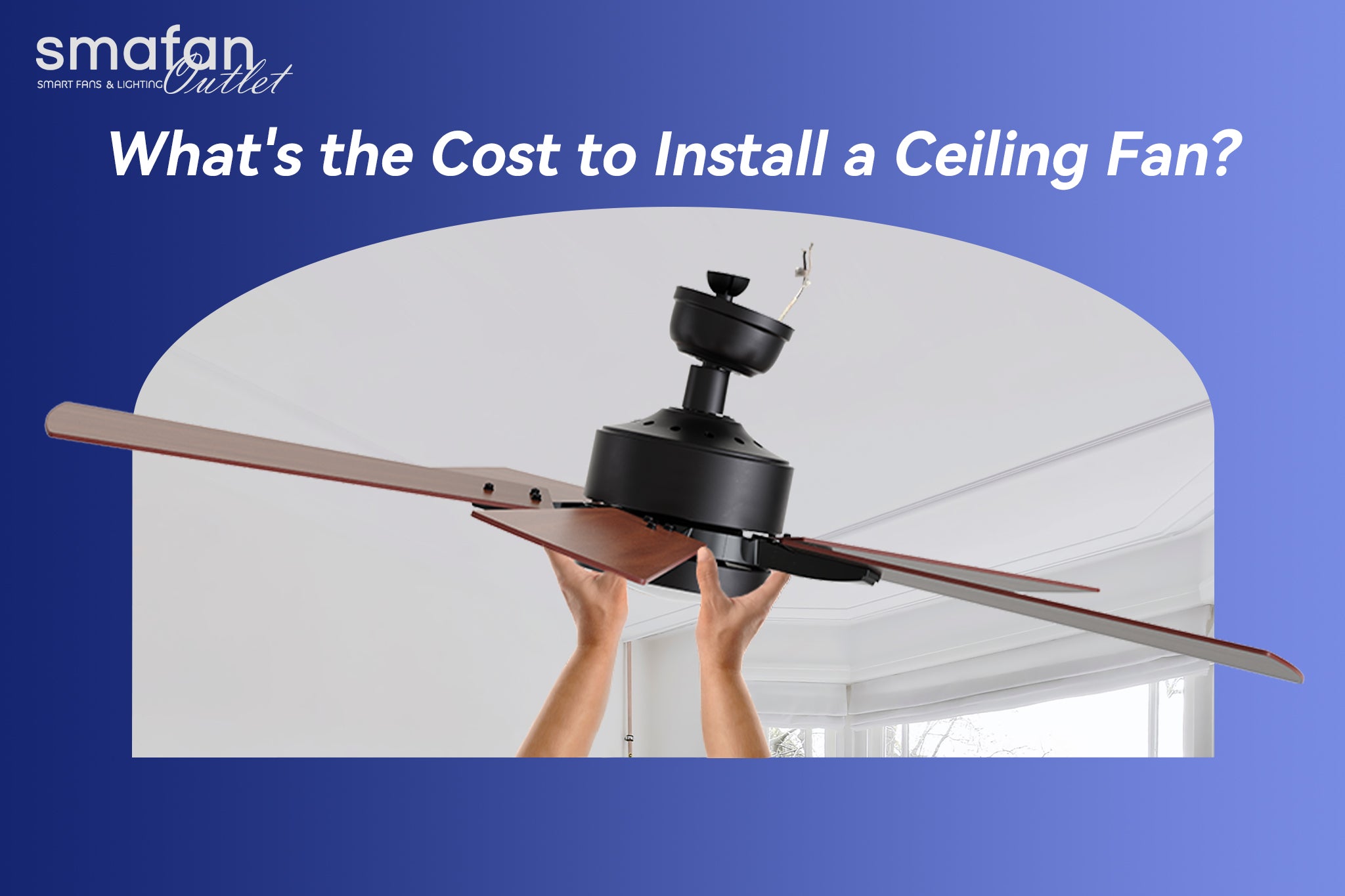Installing a ceiling fan is a popular home improvement project that enhances comfort and reduces energy costs. However, the cost to install a ceiling fan can vary significantly based on several factors. This guide will help you understand these variables, providing a clear picture of what to expect when budgeting for this upgrade.
Average Ceiling Fan Installation Cost
The average ceiling fan installation cost ranges from $200 to $700, including the fan and labor when new wiring is required. The cost of an electrician per hour varies by location, but it typically ranges from $50 to $100. Installation can take between one to two and a half hours depending on the ceiling fan, existing electrical work, and ceiling height.
Replacing an existing ceiling fan costs between $100 and $500, with labor alone costing $50 to $200. New ceiling fan prices vary from $50 to $1400, depending on the size, style, and features.
Factors Affecting Ceiling Fan Installation Cost
Installing a ceiling fan involves several factors that can influence the overall cost. Understanding these variables is crucial for effective budgeting and planning.
Ceiling Fan Cost
The cost of the ceiling fan itself is a primary factor. Prices range from $50 to $1,400, depending on the model, size, and features:
Cost of Accessories
Additional accessories can impact the total cost of installation:
- Remote Control Kits: $15 - $30
- Angled Ceiling Mounts: $20 - $40
- Smart Wall Switch Kits: $45 - $60
- Decorative Elements: $5 - $50
Labor Costs
Labor costs depend on the complexity of the installation and the condition of existing wiring:
- Simple Installations (existing wiring): $50 - $200
- Complex Installations (new wiring, special features): $200 - $2,000
- Electrician Rates: $50 - $100 per hour
Replacing an Existing Fan
Replacing an existing ceiling fan can be less expensive compared to a new installation since the wiring and mount are already in place. The cost varies based on the fan type and any additional work required:
- Simple Replacement: $50 - $150
- Complex Replacement (upgrading to a larger or more advanced fan): $150 - $500
Ceiling Height
Fans installed in vaulted or high ceilings generally cost more due to the extra labor and equipment required:
- Standard Ceiling (up to 8 feet): No additional cost
- High Ceilings (9 - 12 feet): Additional costs due to extra labor and equipment
- Vaulted Ceilings: Significant additional costs due to increased complexity and equipment needs
The cost to install a ceiling fan includes the fan's price, accessory costs, labor charges, and additional factors such as replacing an existing fan and ceiling height. By considering these factors, homeowners can better budget and plan for their ceiling fan installation, ensuring a smooth and cost-effective process.

Cost Breakdown by Wiring Type
When evaluating the cost to install a ceiling fan, the type of wiring present plays a pivotal role. This section delves into the financial implications of installation with existing wiring versus without, providing homeowners a clearer picture of potential expenses.
Installation with Existing Wiring
- Basic Installation: For homes with existing wiring, the cost of installing a ceiling fan is significantly lower. A professional might charge between $100 and $500. This reduced cost covers using the current wiring setup and mounting the fan without extensive electrical work.
Installation without Existing Wiring
- Starting from Scratch: Homes without pre-existing ceiling wiring require more extensive work, which can elevate costs up to $2,000. This comprehensive installation includes running new wires, installing necessary electrical boxes, and setting up a new electrical path for the ceiling fan.
Additional Costs for Safety Upgrades
For homes without existing wiring, adding AFCI circuit protection can further increase costs. This involves the installation of a new Arc Fault Circuit Interrupt breaker, ensuring safety and compliance with electrical standards.
Cost Breakdown by Fan Type
The type of ceiling fan selected significantly impacts the installation cost due to variations in unit prices and features. Here's a detailed breakdown by fan type:
Standard Ceiling Fans
Most residences are equipped with at least one standard ceiling fan, characterized by three blades or five blades, and often feature a built-in light fixture. These fans, which may include a pull chain for operation, are available in various sizes and finishes. The cost for standard ceiling fans ranges from $50 to $300.
Low-Profile Fans
Ideal for rooms with ceilings 8 feet or lower, low-profile fans, also known as flush mounts or huggers, maintain a close proximity to the ceiling. These fans are priced similarly to standard models, ranging from $50 to $300, and are designed to optimize space without compromising performance.
Hanging Propeller Fans
Rooms with high ceilings benefit from hanging propeller fans, which are mounted on a downrod to create extra distance between the ceiling and the fan blades. Best suited for ceilings 9 feet or higher, these fans ensure optimal airflow and are priced between $150 and $550.
Directional Fans
Directional fans offer the unique ability to adjust airflow direction. Mounted on an adjustable downrod and often enclosed in a safety cage, these fans are perfect for directing air to specific areas. The cost for directional fans varies from $150 to $800.
Rotational Fans
For large spaces requiring enhanced air circulation, rotational or dual-motor fans are an excellent choice. These fans feature two or more fan heads on a single central downrod, allowing for greater air movement. Prices for these advanced models range from $200 to $1,500.
| Fan Type | Standard Ceiling Fans | Low-Profile Fans | Hanging Propeller Fans | Directional Fans | Rotational Fans |
| Price Range | $50 – $300 | $50 – $300 | $150 – $550 | $150 – $800 | $200 – $1,500 |
This breakdown illustrates the diversity in ceiling fan types and their respective costs, highlighting the importance of selecting a fan that not only fits the aesthetic and functional needs of a space but also aligns with the budget allocated for the installation.
DIY vs. Hiring a Professional for Ceiling Fan Installation
Pros and Cons of DIY Installation
Cost-Effectiveness
Undertaking the installation of a ceiling fan by oneself can significantly reduce expenses, primarily by eliminating labor costs. This is an attractive option for those with a tight budget.
Learning Opportunity
DIY installation provides homeowners with a chance to learn a new skill and gain a better understanding of their home's electrical systems.
Risk of Improper Installation
Without the proper tools and expertise, DIY enthusiasts may face challenges such as incorrect wiring or insecure mounting, which can lead to safety hazards or damage to the property.
Time Consumption
For those inexperienced with electrical installations, what might seem like a simple task can become time-consuming, potentially requiring multiple attempts to get it right.
Pros and Cons of Hiring a Professional
Expertise and Safety
Licensed electricians bring the necessary training and tools to ensure that the ceiling fan is installed safely and correctly. Their expertise helps in handling complex wiring systems and troubleshooting unforeseen issues during installation.
Liability and Assurance
Professionals carry insurance that covers any damages or accidents that might occur during installation, offering homeowners peace of mind.
Cost Implications
While hiring a professional ensures safety and q uality, it does increase the overall cost of installation. This might not be the most economical option for those on a strict budget.
Convenience
Employing a professional saves homeowners from the hassle and physical labor involved in installation, making it a convenient choice, especially for those with busy schedules or limited DIY skills.
Conclusion
Understanding ceiling fan installation costs in 2024 involves considering fan type, wiring requirements, and whether to DIY or hire a professional. Choosing a fan that fits your budget, matches your decor, and is easy to install can simplify the process. For complex installations, professional help is advisable. Balance cost, convenience, and style to enhance your home’s comfort efficiently.
Recommendation: If you're looking for a ceiling fan that combines affordability, style, and ease of installation, consider our line of easy-to-install ceiling fans. Designed with DIY enthusiasts in mind, our fans come with clear instructions and all necessary mounting hardware, ensuring a smooth and quick setup. This makes them an excellent choice for homeowners wanting to save on labor costs while still achieving a professional look and function.
FAQs
What is the typical cost for installing a ceiling fan?
The average cost for ceiling fan installation across the nation is approximately $250. However, this can vary significantly, with prices ranging from $100 to $600 or more, depending on the project's complexity. For comparison, installing common air conditioning units typically costs between $500 and $2,500, while repair costs generally fall between $100 and $2,000.
How is the installation price for a ceiling fan determined?
The length of downrods, which usually range from 2 to 4 feet but may be longer for high ceilings, can influence the cost. The price for most hanging propeller fans spans from $150 to $550. Therefore, for a straightforward installation, you can expect the installation cost to be between $300 and $900, considering the average installation cost ranges from $150 to $350.
What is a reasonable price to pay for a ceiling fan itself?
This question implies that the cost of purchasing a ceiling fan can vary widely based on factors such as brand, style, and features. While the question doesn't provide a specific answer, it's important to consider that the price of the fan itself will be in addition to the installation costs mentioned earlier.
How long does it take a professional to install a ceiling fan?
A professional typically takes 1-3 hours to install a ceiling fan, depending on the complexity. However, for ceiling fans with easy installation features, a professional can complete the job in 30 minutes or less.








































